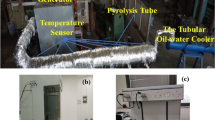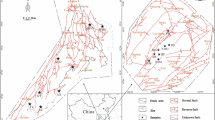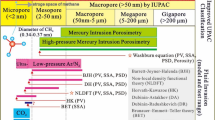Abstract
Understanding multiphase flow properties is essential for assessing and exploiting coals. These properties depend on the 3D pore space information, i.e. geometry and topology. However, determining the geometric and topological properties in coals are still challenging due to the complicated pore structures comprising several length scales. Studying pore scale structures in coals in a continuous range across over several length scales and integrating these information are necessary to increase the understanding of the role of pore structure on transport properties. Most of the current modeling methods are usually based on one or two experimental methods with limited and insufficient information. In this work, CO2 adsorption, N2 adsorption, MIP, X-ray µ-CT and FIB–SEM are used to study the pore structure characteristics of coal samples cored from the No. 9 coal seam of upper Permian Longtan formation at the Longfeng mine, China. The porosity, pore surface area, pore size distribution, connectivity and pore shapes measured by different methods are analyzed. We show that a combination of these techniques provides a richer picture of pore structure in coals. The obtained 3D pore structure can be applied to predict transport properties which are important to capture coal mine methane (CMM) and optimize field development. The results will also be helpful for the gas control in coal mines.
















Similar content being viewed by others
References
Abramoff MP, Ram SJ (2004) Image processing with ImageJ. Biophoton Int 11(7):36–42
Barrett EP, Joyner LG, Halenda PP (1951) The determination of pore volume and area distributions in porous substances. I. Computations from nitrogen isotherms. J Am Chem Soc 73:373–380
Broekhoff J, De Boer J (1967) Studies on pore systems in catalysts: IX. Calculation of pore distributions from the adsorption branch of nitrogen sorption isotherms in the case of open cylindrical pores A. Fundamental equations. J Catal 9:8–14
Brunauer S, Emmett PH, Teller E (1938) Adsorption of gases in multimolecular layers. J Am Chem Soc 60:309–319
Cai Y, Liu D, Pan Z, Yao Y, Li J, Qiu Y (2013) Pore structure and its impact on CH4 adsorption capacity and flow capability of bituminous and subbituminous coals from Northeast China. Fuel 103:258–268
Clarkson C, Bustin R (1999) The effect of pore structure and gas pressure upon the transport properties of coal: a laboratory and modeling study. 1. Isotherms and pore volume distributions. Fuel 78:1333–1344
Clarkson CR, Jensen JL, Pedersen PK, Freeman M (2012) Innovative methods for flow-unit and pore-structure analyses in a tight siltstone and shale gas reservoir. AAPG Bull 96:355–374
Clarkson CR, Solano N, Bustin RM, Bustin A, Chalmers G, He L, Melnichenko YB, Radliński A, Blach TP (2013) Pore structure characterization of North American shale gas reservoirs using USANS/SANS, gas adsorption, and mercury intrusion. Fuel 103:606–616
Dubinin MM (1975) Progr Surf Memb Sci pp 1–3
Europe UNECF, Partnership, MTM (2010) Best practice guidance for effective methane drainage and use in coal mines. United Nations Publications, New York
Fire A (1995) FEI Visualization Sciences Group (VSG), SAS, Konrad-Zuse-Zentrum. Berlin (ZIB) 2013:1990–2013
Fu H, Tang D, Xu T, Xu H, Tao S, Li S, Yin Z, Chen B, Zhang C, Wang L (2017) Characteristics of pore structure and fractal dimension of low-rank coal: a case study of Lower Jurassic Xishanyao coal in the southern Junggar Basin, NW China. Fuel 193:254–264
Granite EJ, Freeman MC, Hargis RA, Odowd WJ, Pennline HW (2007) The thief process for mercury removal from flue gas. J Environ Manag 84:628–634
Groen JC, Peffer LA, Pérez-Ramı́rez J (2003) Pore size determination in modified micro-and mesoporous materials. Pitfalls and limitations in gas adsorption data analysis. Microporous Mesoporous Mater 60:1–17
Horváth G, Kawazoe K (1983) Method for the calculation of effective pore size distribution in molecular sieve carbon. J Chem Eng Jpn 16:470–475
Karacan CÖ, Ruiz FA, Cotè M, Phipps S (2011) Coal mine methane: a review of capture and utilization practices with benefits to mining safety and to greenhouse gas reduction. Int J Coal Geol 86:121–156
Keller LM, Holzer L, Schuetz P, Gasser P (2013) Pore space relevant for gas permeability in Opalinus clay: statistical analysis of homogeneity, percolation, and representative volume element. J Geophys Res Solid Earth 118:2799–2812
Klobes PMK, Munro RG (2006) Porosity and specific surface area measurements for solid materials. In: Recommended Practice Guide Special Publication, pp 960–17
Kruk M, Jaroniec M, Sayari A (1997) Application of large pore MCM-41 molecular sieves to improve pore size analysis using nitrogen adsorption measurements. Langmuir 13:6267–6273
Lozano-Castelló D, Cazorla-Amorós D, Linares-Solano A (2004) Usefulness of CO2 adsorption at 273 K for the characterization of porous carbons. Carbon 42:1233–1242
Münch B, Holzer L (2008) Contradicting geometrical concepts in pore size analysis attained with electron microscopy and mercury intrusion. J Am Ceram Soc 91:4059–4067
Nie B, Liu X, Yang L, Meng J, Li X (2015) Pore structure characterization of different rank coals using gas adsorption and scanning electron microscopy. Fuel 158:908–917
Okolo GN, Everson RC, Neomagus HWJP, Roberts MJ, Sakurovs R (2015) Comparing the porosity and surface areas of coal as measured by gas adsorption, mercury intrusion and SAXS techniques. Fuel 141:293–304
Rigby SP, Edler KJ (2002) The influence of mercury contact angle, surface tension, and retraction mechanism on the interpretation of mercury porosimetry data. J Colloid Interface Sci 250:175–190
Saito A, Foley H (1991) Curvature and parametric sensitivity in models for adsorption in micropores. AIChE J 37:429–436
Sing KSW, Everett DH, Haul RAW, Moscou L, Pierotti RA, Rouquerol J, Siemienewska T (1985) Pure Appl Chem pp 603–619
Song S-B, Liu J-F, Yang D-S, Ni H-Y, Huang B-X, Zhang K, Mao X-B (2019) Pore structure characterization and permeability prediction of coal samples based on SEM images. J Nat Gas Sci Eng 67:160–171
Thomas JJ, Damberger HH (1976) Internal surface area, moisture content, and porosity of Illinois coals: variations with coal rank. Illinois State Geological Survey, Urbana (USA), p. Medium: X; Size, p 44
Tian H, Pan L, Xiao X, Wilkins RW, Meng Z, Huang B (2013) A preliminary study on the pore characterization of Lower Silurian black shales in the Chuandong Thrust Fold Belt, southwestern China using low pressure N2 adsorption and FE-SEM methods. Mar Pet Geol 48:8–19
Wang Z, Cheng Y, Zhang K, Hao C, Wang L, Li W, Hu B (2018) Characteristics of microscopic pore structure and fractal dimension of bituminous coal by cyclic gas adsorption/desorption: an experimental study. Fuel 232:495–505
Warmuzinski K (2008) Harnessing methane emissions from coal mining. Process Saf Environ Prot 86:315–320
Xiong Q, Baychev TG, Jivkov AP (2016a) Review of pore network modelling of porous media: experimental characterisations, network constructions and applications to reactive transport. J Contam Hydrol 192:101–117
Xiong Q, Jivkov AP, Ahmad SM (2016b) Modelling reactive diffusion in clays with two-phase-informed pore networks. Appl Clay Sci 119:222–228
Yao Y, Liu D, Che Y, Tang D, Tang S, Huang W (2009) Non-destructive characterization of coal samples from China using microfocus X-ray computed tomography. Int J Coal Geol 80:113–123
Acknowledgements
The authors gratefully acknowledge the support of the National Natural Science Foundation of China (Grant Nos. 51879260, 41572290, 51879258), of the Chinese Fundamental Research (973) Program through the Grant No. 2015CB057906, CAS Interdisciplinary Innovation Team (JCTD-2018-17), and Hubei Provincial Natural Science Foundation of China (2018CFA012).
Author information
Authors and Affiliations
Corresponding author
Additional information
Publisher's Note
Springer Nature remains neutral with regard to jurisdictional claims in published maps and institutional affiliations.
Rights and permissions
About this article
Cite this article
Xiong, Q., Li, K., Yang, D. et al. Characterizing coal pore space by gas adsorption, mercury intrusion, FIB–SEM and µ-CT. Environ Earth Sci 79, 209 (2020). https://doi.org/10.1007/s12665-020-08950-3
Received:
Accepted:
Published:
DOI: https://doi.org/10.1007/s12665-020-08950-3




